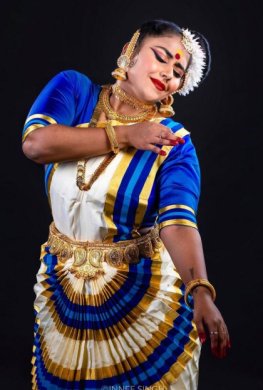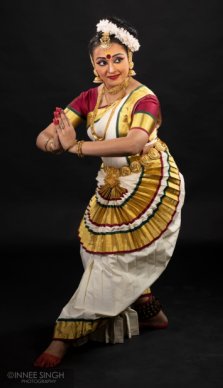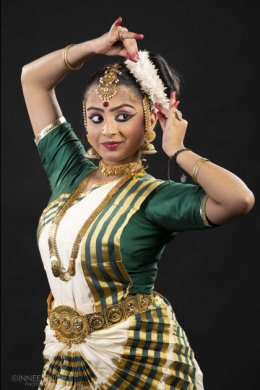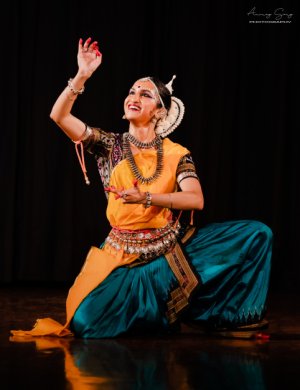
|   |

|   |
 e-mail: leelakaverivenkat@gmail.com Young talent played its part too November 11, 2022 While much of my writing surrounds high profile events held in the capital, one tends to forget the part played by young talent. Belatedly, to compensate for the lack of coverage given to their participation, I begin with mention of Nava Lavanyam, presented by International Academy of Mohiniyattam, wherein one was treated to how Mohiniattam dancer Jayaprabha Menon's approach to training her students with constant exposure to Theyyam, Kalaripayattu and Sopana Sangeetam, along with providing sufficient room for self-expression by the student, supported, when needed by teacher guidance, would seem to be paying dividends. The evening saw a presentation of self-choreographed, original items by most of the students, and what impressed was the apparent effort, varying ability in each performer notwithstanding, at internalizing the chosen theme, instead of a superficial treatment. The evening began with a Swathi Tirunal lyric Madhupavalitakhandam, sung in viruttam and set to ragam Hamsadhwani, dedicated to Ganapathy, presented by the entire group, and even while each dancer seemed involved, Jayaprabha's concept of group choreography, while adequate, is not exceptional.  Thankam Krishnan  Reji Anoop The best of the evening came from Thankam Krishnan's sensitive presentation of Ganga Tatvam, the lyric set to ragam Charukesi composed by late Kavalam Narayana Panikkar in praise of river Ganga, which, in the face of selfishness of man and a thankless world, continues to nourish Earth, providing sustenance. In terms of mukhaabhinaya, the dancer's refined ability, with quivering nostrils and quick changing expressions, to portray the moods of the Ganga, with her flowing waters assuming different characters, was out of the ordinary, and this dancer, given the right opportunities for performing, seems set for an eventful career. Reji Anoop had conceptualised a version of Sita, based on excerpts from Janaki Mangal and Ramcharitmanas set to Punnagavarali ragam, with music set by Kottakkal Jayant and Jayaprabha, wherein as an embodiment of patience, love and forgiveness, Sita is paid homage to as a figure of immortal significance, for all time. For a person with a full time job in the ministry of Defence and the Department of Personnel and training, the dance involvement was surprising. The other heroine from the epics, Draupadi, was taken up for treatment in a presentation by Nivedita Cholayil (also a government official) again the dancer's own concept, through a composition set to ragam Shubhapantuvarali, wherein Draupadi is sensitively portrayed expressing her anguish at Krishna's setting off on an errand of reconciliation with the Kauravas - even as her open hair remains a reminder of her humiliation in court.  Nivedita Cholayil  Ananya Nair Not trying to venture outside the Mohiniattam repertoire, were Radhika Menon who presented Mukhachalam set to ragam Surutti, Ananya Nair who rendered a Swati Tirunal Utsavaprabandha Kriti, and Sruthi R. Krishna who rendered Swati Tirunal's padam Poondendumozhi in Anandabhairavi and Punnagvarali wherein the Nayika mourns over the now lost closeness with the lover. Constant interruptions between items, inviting artistes of various schools of dance in the audience, on to the stage to felicitate them, prolonged the programme duration. While public relations, admittedly, are of paramount importance for the dance fraternity, such formalities indulged in at the end would ensure that attendance for dancers performing towards the latter half does not get to be very thin, because of the late hour. Even this critic missed the last three presentations. The picture in the brochure of (perhaps a still from the concluding item one missed) animated expressional faces gathered round the teacher, is very impressive and is a hearty vote of confidence for dance training concentrating on sharpening interpretative skills. Accompanying artists Kottakkal Jayan (vocalist), Swati Das, Satheesh Poduval (edakka), Kiran Kumar Sharma (flute) provided the right kind of support from the wings. At the India International Centre's Deshmukh auditorium, the Centre's Double Bill concert saw Prerana Shrimali's student Arthi Srivastava take the stage in a Kathak performance. Neatly turned out and looking the picture of confidence, the start was an invocation to Shiva and chiming in with this Natwar Natraj's rhythmics, what followed as nritta in Dhamar taal was very skillfully rendered. Clarity of footwork and precision in measurement of time, and good improvisational ability marked Arthi's short tatkar presentation, and the 'Thata', Paran, Amad, the 'farmaish' tukra, plus a fine Kavit. In the chaalis was the elephant's dignified walk. The abhinaya part was based on the Pootana episode - most certainly not part of usual fare for Kathak - and here full marks to her teacher Prerana Shrimali who had crafted this item very intelligently to make it fit into the Kathak vocabulary. And it was efficiently presented. Arthi is yet to develop a feel for interpretative items based on sringar poetry or ched/chad of love. Under the circumstances, the Pootana item devised for her was in keeping with her interpretative abilities. Shakeel Ahmed Khan on tabla, Imran Khan (vocal), Shireen Faraz on Sarangi and Prerana's student Nishtha Budhala Kothi for parhant provided the right support.  Sangini Kumar Sangini's Odissi in the second half of the evening, brought back echoes of Mayadhar Raut's Odissi style, which is less often seen, when compared to the other styles in this tradition. It has a distinct quality, even in the form of the music for the dance. No other Odissi style reminds me as much of the fifties with the "Utha, Baitha, Thia, Chali, Buda, Bhasa, Bhauri, Pali, Bhanga" technique that Kalavikash Kendra students of those days practiced. And one saw the best crystallization of Guru Mayadhar's style, in Kiran Segal's peak dancing days. Watching Sangini, Kiran's student perform Satya Maharana's Swar Pallavi, after the "Vakratunda Mahakaya Sooryakoti Samaprabha" prayer to Ganesh, togo on to the abhinaya item based on poet Banamali's composition Sanginire chaha set to Kalavati with the nritta part resonating with what the old teachers like Singhari Shyam Sundar Kaur taught, one was strongly reminded of the days in the late fifties. Along with the technical grasp which Sangini certainly has, a finer feel for the lyricism of the Odissi technique, would enhance the grace in her dance. The last item "Jago Maheswara," a choreography of Mayadhar Raut , which was always Kiran's piece de resistance in her performances, the episodes connected with Shiva, like his swallowing poison and acquiring the blue throat, his reducing Kamadev to ashes with the fire of his third eye, the descent of Ganga lodged in his locks etc, saw an involved Sangini - her animated expressional aspect keeping pace with the rhythmic. Prafulla Mangaraj on mardala, Prashant Behera for vocal support, Dheeraj Pande on the flute, Rais Khan on the sitar and Kiran Segal herself playing the manjira were the accompanying artistes. Away from the young talent presentations, at the Islamic Centre, the NPSC, post its 49th Annual Conference with the theme Bridging the Gap for a Sustainable and Inclusive Learning World, marked its Amrit Mahotsav of entering the 50th year, by presenting Navina Jafa (who herself has been very active in the field of education and learning) in a Kathak performance. A student of late Guru Birju Maharaj, Navina while not a constant performer, has creditably in the midst of all her multifarious activities, kept the dance touch alive. By narrating during the programme, constant links provided by her Guru's teachings, Navina tried to make a concert presentation, as far as possible, fit into an educational mould suiting the NPSC occasion. But whoever was responsible for the preparation of the stage, had allowed enthusiasm to get the better of wisdom. Instead of a plain, preferably black backdrop ideal for a solo dance performance, the rear curtain with a Mandala type drawing in over bright colours took away all the light, with the dancer's face in the dark with expressions not registering, during the first few minutes particularly. The edge of the stage, with decorative clusters of lilies at regular intervals to hide the light contraptions on the stage, should have been kept in mind while arranging the foot mike (ideally in between these) so that the dancer's feet, while executing footwork so important to Kathak, did not get hidden. Since NPSC works with children's education, Navina began with a theme dealing with the child "Thumak chalat Rama Chandra" from Tulsidas Ramayana describing mother Kaushalya delighting in playing with toddler Ram, with his unsteady walk. While the dancer was interpreting it with feeling, the singing with two vocalists, not finding unified microtonal agreement, was a total distraction, which could have been avoided and here strangely, singer Imran sounded strangely out of depth. Not in the league of tossing out exhilarating footwork improvisations, Navina's Upaj, particularly in the Jugalbandi with its 3,4,5,7 and 9 combinations, had clarity and correctness. Above all, her Kathak has a great feel for lyricism and grace in movement - and in linking each of the nritta projections as in the elephant gait with the Mahout on top, and the bols in the takita takita dhin ladhi (where the assertive sounds are contrasted by the soft almost sensual dhin), to observations of her late Guru, she kept up the idea of Guru/shishya transmission in art teaching and educating young minds. In keeping with Kathak as the art form born out of the story teller's skills, the dancer referred to the 400 year old Kavad mobile story telling art of Rajasthan from Mewar. The Kumawad's art comprises a wooden box which is like a moving shrine - a cabinet with many folding doors, full of paintings and pictures of Gods and personalities, with the story telling based on what these pictures represent. The best of Navina's recital came in the Hazrat Amir Khusro Hindavi "Eri Sakhi piya ghar nahi aye". Seeing his reflection in the water, confiding in the pet parrot, as the nayika expresses her longing, the dancer's absorbed interpretation combined with Imran Khan's tuneful and soulful singing (which seemed a different incarnation from the earlier version, where he could not hold the notes), this provided a perfect ending, with the audience showing its whole hearted approval.  Writing on the dance scene for the last forty years, Leela Venkataraman's incisive comments on performances of all dance forms, participation in dance discussions both in India and abroad, and as a regular contributor to Hindu Friday Review, journals like Sruti and Nartanam, makes her voice respected for its balanced critiquing. She is the author of several books like Indian Classical dance: Tradition in Transition, Classical Dance in India and Indian Classical dance: The Renaissance and Beyond. Post your comments Pl provide your name and email id along with your comment. All appropriate comments posted with name and email id in the blog will also be featured in the site. |